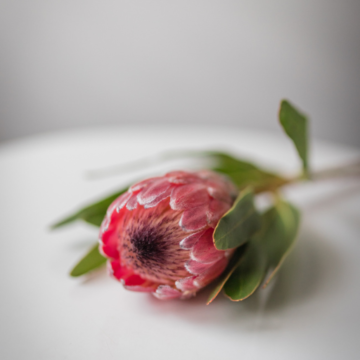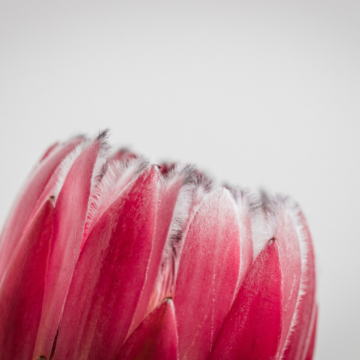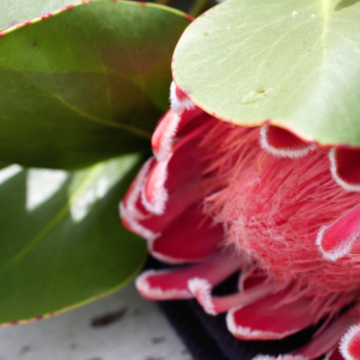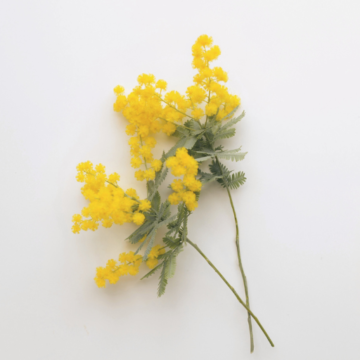Nature’s gallery is filled with an array of wonders, and among them stands the Pink Ice Protea, a masterpiece that defies conventional floral norms. Nestled within the Proteaceae family, the Pink Ice Protea, scientifically known as Leucospermum cordifolium ‘Pink Ice,’ captivates the beholder with its intriguing structure and colours.
The journey of the Pink Ice Protea commences on the rugged landscapes of South Africa, where it thrives as a member of the Proteaceae family. Its captivating beauty has roots intertwined with the history of the Cape of Good Hope, where Dutch explorers marveled at its unconventional elegance. Distinguished by its captivating hues, the Pink Ice Protea swiftly ascended to a symbol of fascination and allure.

Within South African culture, the Pink Ice Protea holds profound significance. This captivating flower claims the title of South Africa’s national flower, representing diversity, courage and metamorphosis. The indigenous Khoi and San communities recognised its value, harnessing its beauty for ornamental and medicinal purposes alike.
Artists and visionaries find themselves entranced by the Pink Ice Protea’s beguiling structure. Its intricate bracts and calming colours have been immortalised in myriad forms of artistic expression, from paintings to sculptures. Such creations not only capture the flower’s aesthetics but also its ability to evoke emotions and ignite creativity.
The Pink Ice Protea transcends mere aesthetics, encompassing symbolism and essence. A symbol of courage and transformation, this bloom serves as a reminder that even within harsh environments, beauty can thrive. Its adaptive nature and resilience have made it an emblem of strength and endurance.
Beyond its visual allure, the Pink Ice Protea is thought to possess potential healing properties. Traditional medicine has utilised it for an array of conditions, from skin afflictions to digestive woes. While scientific validation may be limited, its mere presence is a balm for the soul.
In the realm of floriculture, the Pink Ice Protea holds a distinct allure. Its unique structure and vibrant bracts render it a sought-after choice for floral arrangements, infusing a touch of exotic grace and that wild flower look into any setting.

The Pink Ice Protea flourishes harmoniously within South Africa’s diverse landscapes, particularly thriving within the fynbos biome. This unique environment has shaped the Protea’s resilience, equipping it to withstand nutrient-deprived soils and fire-prone regions. Such adaptations contribute not only to its distinctive appearance but also its ability to prosper despite adversities. https://www.proteaflora.com.au/proteaflora-plants/protea/special-pink-ice/#:~:text=Protea%20Special%20Pink%20Ice%20is,gardens%20and%20cut%20flower%20growers.
As cut flowers, Pink Ice Proteas boast a commendable vase life of up to two weeks, given proper care.
- Trimming: Cut stems at an angle before placing them in fresh, cool water.
- Water: Ensure the vase remains filled with clean water; change it every few days.
- Environment: Position the vase in a cool, shaded spot, away from direct sunlight and drafts.
- Hydration: Spritz the flowers gently with water to maintain their freshness.
The Pink Ice Protea’s presence transcends visual delight; it extends a nurturing embrace to the mind. Studies highlight the positive impact of nature and flowers on mental health, offering respite from stress and fostering a sense of well-being. https://positivepsychology.com/positive-effects-of-nature/ The Protea’s vibrant hues and intricate bracts bestow tranquility and rejuvenation upon the observer.

The Pink Ice Protea stands as an eloquent testament to nature’s artistry and endurance. From its storied past and cultural resonance to its latent healing attributes and impact on mental well-being, this captivating flower captivates hearts and souls alike. Whether adorning South Africa’s landscapes or gracing a vase with its presence, the Pink Ice Protea remains an enduring emblem of beauty, strength and metamorphosis, ceaselessly inspiring and uplifting.
To Learn how you can benefit from the power of protea energy see Yvettes calendar for availability on Flower Therapy Sessions or join the waitlist! – Learn More













